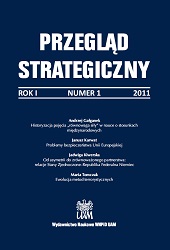TERRORIST ATTACKS VERSUS ACTS OF ILLEGAL
INTERFERENCE IN CIVIL AVIATION. IMPLICATIONS FOR THE FUNCTIONING OF AIRPORT CRITICAL INFRASTRUCTURE
TERRORIST ATTACKS VERSUS ACTS OF ILLEGAL
INTERFERENCE IN CIVIL AVIATION. IMPLICATIONS FOR THE FUNCTIONING OF AIRPORT CRITICAL INFRASTRUCTURE
Author(s): Adrian SiadkowskiSubject(s): Security and defense, Military policy
Published by: Uniwersytet im. Adama Mickiewicza w Poznaniu
Keywords: terrorism
Summary/Abstract: Hijackings, assaults and attacks on means of transport had existed long before the invention of the airplane. In past centuries, criminal acts were mainly robbing mail-coaches or pirate attacks on trade ships. The practice of keeping hostages for ransom, however, has survived from ancient times up to the present day. Kidnappings and keeping hostages favoured the achievement of economical, strategic and tactical goals. The aims of hijackings and attacks were both obtaining money for further criminal activities, as well as an expression of protest against government policy or for the creation of a terror atmosphere in order to publicise the case, and thus influence politics. It is worth mentioning, while the media maintain the presence of the Islamic terrorist wave, that the founder of Islam – Muhammad the Prophet, conducted attacks on caravans of camels. The motivation of criminals is changeable and non-heterogeneous, and has been the object of various repercussions, preventative measures and applied security systems.
Journal: Przegląd Strategiczny
- Issue Year: I/2011
- Issue No: 1
- Page Range: 237-246
- Page Count: 10
- Language: Polish

